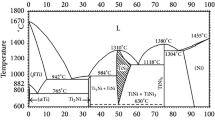Abstract
The welded joints of a nitinol (Ti–55.42% Ni) wire 2 mm in diameter are fabricated using a manual tungsten inert gas welding technology (TIG). The macro- and microstructure of the welded joints are investigated, bending tests are carried out, and the shape memory effect is evaluated.








Similar content being viewed by others
REFERENCES
K. Ootsuka, K. Simudzu, Yu. Sudzuki, et al., Shape Memory Alloys, Ed. by Kh. Funakubo (Metallurgiya, Moscow, 1990).
Y. G. Song, W. S. Li, L. Li, and Y. F. Zheng, “The influence of laser welding parameters on the microstructure and mechanical property of the as-jointed NiTi alloy wires,” Mater. Lett. 62, 2325–2328 (2008).
Gong Wei-Huai, Chen Yu-Hua, and Ke Li-Ming, “Microstructure and properties of laser micro welded joint of TiNi shape memory alloy,” Trans. Nonferrous Met. Soc. China 21, 2044–2048 (2011).
P. Schlossmacher, T. Haas, and A. Schüssler, “Laser-welding of a Ni-rich TiNi shape memory alloy: mechanical behavior,” J. Phys. IV France 7, 5–252 (1997).
B. Tam, M. I. Khan, and Y. Zhou, “Mechanical and functional properties of laser-welded Ti–55.8 wt pct Ni nitinol wires,” Metall. Mater. Trans. A 42, August, 2166 (2011).
S. S. Mani Prabu, H. C. Madhu, S. Perugu Chandra, K. Akash, P. Ajay Kumar, V. Satish Kailas, Manivannan Anbarasu, and I. A. Palani, “Microstructure, mechanical properties and shape memory behaviour of friction stir welded nitinol,” Mater. Sci. Eng., A (2017).
S. S. Mani Prabu, H. C. Madhu, S. Perugu Chandra, K. Akash, R. Mithum, P. Ajay Kumar, V. Satish Kailas, Manivannan Anbarasu, and I. A. Palani, “Shape memory effect, temperature distribution and mechanical properties of friction stir welded nitinol,” J. Alloys Compd. (2018).
V. Delobelle, P. Delobelle, Y. Liu, D. Favier, and H. Louche, “Resistance welding of NiTi shape memory alloy tubes,” J. Mater. Proc. Techn. 213, 1139–1145 (2013).
Fox Gordon, Hahnlen Ryan, and J. Dapino Marcelo, “Fusion welding of nickel–titanium and 304 stainless steel tubes: Part II: tungsten inert gas welding,” J. Intell. Mater. Systems Struct. 24 (8), 962–972 (2012).
F. A. Rodrigues Luiz, A. Amorim Fernando, F. R. Pereira Francisco, and J. de Araujo Carlos, “Experimental study of tungsten inert gas pulsed welding applied to Ni–Ti shape memory alloy wires,” Mater. Res. Soc. Symp. Proc. 1765 (2015).
J. P. Oliveira, D. Barbosa, F.M. Braz Fernandes, and R. M. Miranda, “Tungsten inert gas welding of Ni-rich NiTi plates: functional behavior,” Smart Mater. Struct. 25 (2016).
Author information
Authors and Affiliations
Corresponding author
Rights and permissions
About this article
Cite this article
Khismatullin, A.R., Kladov, I.V., Panchenko, O.V. et al. Properties of Ti–Ni Wire Welded Joints. Russ. Metall. 2020, 1570–1574 (2020). https://doi.org/10.1134/S0036029520130133
Received:
Revised:
Accepted:
Published:
Issue Date:
DOI: https://doi.org/10.1134/S0036029520130133




